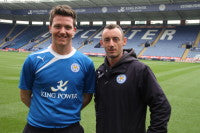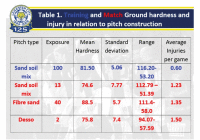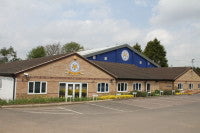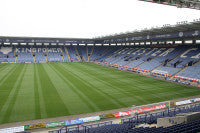Leicester City - Foxes on a run

Promotion to the Barclays Premier League for Leicester City Football Club also marks the return to the top flight for their Head Groundsman, John Ledwidge, who began his career at Coventry City's Highfield Road Stadium under Head Groundsman Michael Finch, before moving to Aston Villa as assistant to Jon Calderwood. "I am indebted to them both," confirms John, "for instilling in me a work ethic and skills sets that will stand me in good stead for the rest of my career."
Following his spell at Villa, John returned to Coventry City to work as Head Groundsman at their new Ricoh Arena stadium, a position he held until his move to Leicester City earlier this year following the departure of their long serving head groundsman, Ed Mowe, who had moved on to the FA's St George's Park complex.
Returning to the Premier League offers many rewards, especially on the financial front. The club will receive additional monies, some of which has been earmarked for improvements to the pitches at the training ground.

"My assistant is Simon Gibson, who has been at the club fifteen years. We have three more groundsmen, Andy Oakes, Paul Billington and Callum Allsop, with Dave Lay looking after all the gardens. We are also considering appointing two new apprentices in the summer."
"It was certainly a baptism of fire," John continues. "In the first three weeks of taking up my new role in January, the weather conditions were 'quite challenging'. Not only was I trying to gauge how the pitches were performing, I needed to find time to attend meetings, meet up with new colleagues and, on top of that, prepare the annual grounds maintenance budgets for the next season, budgeting for either the promise of the Premier League or the reality of Championship football."

"With the club heading back to the Premier League there is an opportunity to invest additional money into these pitches. After some research, and knowing that many clubs had gone down the route of installing similar specified pitches to their stadium pitch, it seemed a logical step for us to go down the same route. Putting together a detailed proposal to take the board of directors within my first four weeks was a daunting task to say the least, but using my experience and knowledge I had gained I managed to persuade the eight directors and the chairman to invest in a new Desso pitch to be built at the training ground, incorporating undersoil heating and drainage and, at the same time, reconstruct and extend another training pitch and incorporate 100mm of fibre rootzone. Local firm Hewitts Sportsturf were awarded the work and started to construct the new pitches on the 18th March."
"With such a tight window for recovery it was important to start this work early, so work commenced on the two main areas on the 17th March, just seven weeks after my arrival" says John. "Hewitts are doing a fantastic job and, after just a few weeks, we are nearing the final stages of the work."

"We also monitor soil and air temperatures, take regular soil samples to keep an eye on nutrient levels and also use a prism gauge to check height of cut."
"As for playability, the manager and players tend to like a fast, zippy and firm pitch so, to achieve this without compromising turf quality, we have developed a programme of maintenance that delivers what they want. We cut the pitch as often as we can to maintain a height of 19mm. After a Saturday match, for example, we clean up with the pedestrian rotaries straight after the game then, on the Monday, run the Toro Pro Core over the pitch to relieve compaction. We'll then rotary cut Monday, Tuesday and Wednesday and, in the meantime, feed or apply some biostimulants depending on the programme."

"We take regular soil and clippings tests and analyse the results to maintain a balanced feeding programme. This generally revolves around a base feed every six to eight weeks with Sierrablen, followed by a fortnightly dose of Greenmaster, topped up with a bespoke dose of biostimulants formulated by Mike Atkins at Soil Harmony."
"We then triple cut for the next two days - Thursday and Friday - followed by a 5.30am start on match day to triple cut and mark out prior to the match using our Dennis cylinder mowers."
"This routine works very well," says John. "I am trying to instill a planned maintenance programme that ensures we keep on top of the pitches and maintain sward quality without getting caught out."

John was keen for me to see the installation of the new pitch, so we made our way over to the training ground to see, at first hand, the work being done.
"The first team training pitch was a complete rebuild," confirms John. "This was done by establishing base levels, installing drainage layers, laying down 200mm of base sand, installing undersoil heating pipes and irrigation and putting on 100mm of 80/20 Mansfield rootzone."
"It was then a case of sewing in the Desso fibres. It's both a fascinating and time consuming process, with three machines on the go. Once the fibres are sewn in, it will be a case of oversowing the pitch with Johnsons Premier Pitch seed mix at 45g/m2, applying a pre-seeder and waiting for germination."

"Once the wall had been completed, we began work on the pitch by removing the top 75mm of old rootzone material, gravel banding to improve the existing primary drainage system and connecting additional lateral drains. This was followed by the installation of 200mm of base sand, topped up with the final 100mm of 80/20 rootzone material and oversown with the same rye grass mix."
"Mowing will start once the grass has reached the two/three leaf stage," confirms John, "using cylinder mowers set at 33mm for the first few cuts until the plant is ready to be rotary mowed."
"As for the remaining training pitches" renovations, these will be taken out of play once the football season has finished and the players go on leave. They will be sprayed with a combination of growth retardants to both suppress the poa and stop any existing grasses from swamping the new seedlings, fraise mown, verti-drained, topdressed with 60 tonnes of Mansfield sand and oversown."

As for equipment, John wants to implement an all pedestrian fleet of equipment for the first team pitches, keeping as much weight off as possible. To enable him to implement this policy, he has secured funds to buy six new Dennis mowers, six new Honda rotaries, two triple cylinder mowers, two new tractors and a Toro Workman with sprayer attachment.
He is also looking at buying additional lighting rigs. Currently, they only have two small goalmouth rigs. Whilst he is still finalising the details, he hopes to have these on site by the autumn.

There are exciting times ahead at Leicester City if the recent investment in the pitches is anything to go by. The club are thinking big and want to give themselves the best chance of staying in the Premier League. If the players can continue where they left off last season, there is no reason why not.
I would like to thank John for his valuable time and for giving Pitchcare an insight into his first few months at his new club.

Dennis G760 x 3
Dennis Premiers x 2
Honda rear roller mowers x 5
Track brush
Kubota tractors x 3
Kyoti Tractor with loader
Toro ProCore - pedestrian
Toro ProCore - tractor mounted
Toro topdresser
Toro Workman
Verti-groom
Sisis Multitine
Sisis Javelin Aer-aid
Sisis Litimisa
Sisis Robi (artificial brush)
Countless Sisis twinplays!
Hardi 400l sprayer
Hardi 200l sprayer
